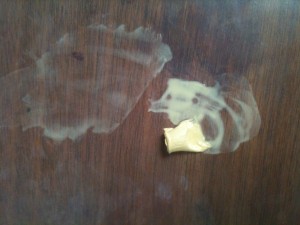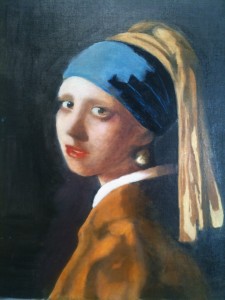|
For several months, I have been glazing a copy of a Vermeer painting, made famous by a film. I shall now expand that sentence.
Glazing is putting on thin layers of paint, with a lot of carrier and comparatively little pigment. This means that you can see through many of the layers at the same time, and gives a translucence to the painting. This is particularly useful for flesh tones, skies, and things where people want to see depth and complication.
A copy is not an alternate version but an attempt to get close to the appearance of an original. A forgery is a copy that someone tries to pass off as an original, but there is nothing inherently illegal about copying a painting.
Vermeer is a dead white man, unless he was secretly a white woman before he became dead, but this is vanishingly unlikely. None of these facts make my respect for his work any less.
The film is Girl with a Pearl Earring, and the eponymous painting is very tough to copy, for a number of reasons. Vermeer, like his general contemporaries, is thought to have used an underpainting followed by many layers of glazes. It not being the done thing to rip apart an Old Master with a band saw, we cannot be certain how this one was painted. However, I am trying a technique close to the one I think he used. Painting thin glazes so that the colours do not blotch is very difficult. A look at my palette with a thin preparation of yellow on it will show the problem:
 It is difficult to judge the consistency of the glaze. I was working here with the thinnest, and it can be seen that the oil in which it is held does not lie flat on the palette. To get it to be flat, I have to spread it very thinly indeed and use many many layers. However, if I mix it any thicker than this, it is easy to see the edges and joins, and I have to alter how I work around the edges. Dark colours show up far more blotchily than light ones, especially dark painting over light – such as the shadows of the face. With Vermeer’s method, the tone would have been in already, and the colour itself added later, but I started with large colour blocks and that means I am continually fighting against blotches. It is difficult to judge the consistency of the glaze. I was working here with the thinnest, and it can be seen that the oil in which it is held does not lie flat on the palette. To get it to be flat, I have to spread it very thinly indeed and use many many layers. However, if I mix it any thicker than this, it is easy to see the edges and joins, and I have to alter how I work around the edges. Dark colours show up far more blotchily than light ones, especially dark painting over light – such as the shadows of the face. With Vermeer’s method, the tone would have been in already, and the colour itself added later, but I started with large colour blocks and that means I am continually fighting against blotches.
The last two days of working on G.W.A.P.E were adding the yellow glaze onto the face and the blue head-dress, which is the next thing on which I need to work, and blacking out the background.
 This is the pre-blacking picture. I have deliberately painted in dark purples and browns and greens on different patches of the background, where I think that the original has shades of colour showing through. It is difficult, because I have never seen the original, copies suffer from inaccuracy, and I am pretty sure that the painting has been over-cleaned. The nose and far cheek do not have enough separation, and I cannot find a decent reproduction of the original to check it. Comments from those who /have/ seen the original are welcome. This is the pre-blacking picture. I have deliberately painted in dark purples and browns and greens on different patches of the background, where I think that the original has shades of colour showing through. It is difficult, because I have never seen the original, copies suffer from inaccuracy, and I am pretty sure that the painting has been over-cleaned. The nose and far cheek do not have enough separation, and I cannot find a decent reproduction of the original to check it. Comments from those who /have/ seen the original are welcome.
I used Terre Cassel instead of black, which I felt would have been too harsh. It is a very dark brown-grey-green colour with solid coverage qualities, and it looks black in most lights. I went over all of the background, and then shadowed the face a little more, and suddenly I could see the attraction in the lighted figure. She really stands out, and the difference between this and the previous iteration is very clear.
 This is the current state of Girl with an Earring that I think is not Pearl. This is the current state of Girl with an Earring that I think is not Pearl.
|